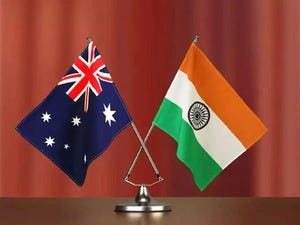The Australia-India Economic Cooperation and Trade Agreement will provide free access to India with approximately 96.4 per cent of exports, among other benefits. Both governments think the agreement will boost bilateral trade to $ 45-50 billion over five years
After 11 years, India and Australia have signed a landmark trade agreement - the Australia-India Economic Cooperation and Trade Agreement (Ind-Aus ECTA).
After the ink dried on the contract, Prime Minister Narendra Modi said, "The trade agreement is an important moment in our relationship."
But, what is this agreement between India and Australia and what does it mean for the country. Here is your explanation.
What is India-Australia ECTA?
It covers almost all the tax cuts mentioned by India and Australia respectively.
India will benefit from the exclusive market access offered by Australia for 100% of its tax lines.
India will provide exclusive access to Australia with more than 70% of its tax lines.
Under the agreement, Indian graduates from STEM (Science, Technology, Engineering and Mathematics) will be issued with postgraduate work visas.
It will provide access to zero duty to 96% of Indian exports to Australia and will provide approximately 85% of Australian exports to access Indian markets.
It will increase trade in goods and services in two countries to USD 45-50 billion over five years, increase from about USD 27 billion, and create more than one million jobs in India, according to government estimates.
What Is Its Importance?
Improved Exports: Currently, Indian exports face a 4-5% tax burden on many labor-intensive sectors compared to competitors in Australian markets such as China, Thailand, Vietnam, South Korea, Japan, Indonesia and Malaysia.
Removing these barriers under ECTA could significantly improve Indian exports.
Cheap Mature Products: Australia's exports to India are mainly focused on raw materials and intermediate products. Due to the inefficient access to 85% of Australian products, many industries in India will have access to cheap and thus highly competitive materials, especially in fields such as steel, aluminium , energy, engineering and more.
Indian Opinion Change: The recent trade agreement will help change the mindset of the developed countries that always label India as ‘defenders’ and address doubts about India’s openness to doing business with the world.
Stronger Indo-Pacific: A strong Australian-India economic relationship will pave the way for a strong Indo-Pacific economic development, not only based on the flow of material goods, money and people, but on the basis of building a strong, cohesive connectivity. , a sustainable and dependable commitment both nationally and sub-regions.
Where Are My Two Countries in Investment Protection?
Although ECTA refers to investment as part of the trade in services, it does not provide investment protection measures such as providing foreign investment in the most popular nation and national governance, asset protection, assurance of fair and equitable investment in foreign investment, with caution. the right of foreign investors to lodge lawsuits against the State for alleged breach of contract.
Article 14.5 of ECTA, which includes a list of topics to be discussed in order to transform the provisional ECTA into a Comprehensive Economic Cooperation Agreement CECA, and does not address the investment protection chapter.
It is important to note that Australia has signed comprehensive economic agreements with Peru, Indonesia, and Hong Kong covering the chapter on investment protection.
On the other hand, the recent CECA of India and the United Arab Emirates (UAE) and Mauritius (signed in 2021) do not include an investment chapter.
A pattern that seems to emerge is that India is not very willing to include a chapter on investment protection in CECAs.
How Can Non-Investment Investment Affect India?
India's reason for signing a comprehensive economic agreement with these countries to be part of the global value chain (GVCs), both, trade and foreign investment is the basis of GVCs.
Therefore, the withdrawal of trade from investment in these CECAs is not in line with economic wisdom.
Many recent major economic agreements such as the RCEP Agreement and the Comprehensive and Progressive Agreement for Trans-Pacific Partnership (CPTPP) include chapters on investment protection.
What could be the Way Forward?
Investment Protection: India's state of excessive protection against investment protection under international law is the result of a number of international claims under BIT.
India must come out of its shell and embrace investment protection as part of its broader economic obligations under international law. This will enable India to see the full potential of these CECAs.
Adding Investment Chapters: If investment protection is made part of those CECAs, India will be in a better position to negotiate balanced investment chapters compared to a private investment agreement.
If a few related issues are part of the same agreement, there is a good chance you will “give and take” and a win-win agreement is reached.
Enhancing Competition: Although the Government of India has successfully negotiated a very good business agreement, it is important to note that access to the Australian market will not be a difficult road given the fact that Australia has 16 operational FTAs.
We will still have to work to improve our competitiveness, as in many trade sectors, India will be competing with China, ASEAN, Chile, Japan, Korea and New Zealand, which already have active FTAs with Australia.
APEC Partnership: Time is also an opportunity for membership of India-Pacific Economic Cooperation (APEC) in India, the goal of free and open Indo-Pacific is not complete without the presence of the fastest growing global economy in APEC.





Nicely explain agreement. Keep poting such type of useful information 👌👌👏👏👏👏👏👏👏👏👏👏
This is just getting better!